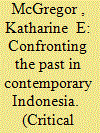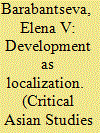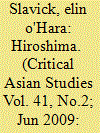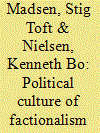|
|
|
Sort Order |
|
|
|
Items / Page
|
|
|
|
|
|
|
| Srl | Item |
| 1 |
ID:
088364


|
|
|
|
|
| Publication |
2009.
|
| Summary/Abstract |
The collapse of authoritarian regimes and the emergence of new democratic spaces hold the promise of an opportunity to redress instances of past violence. Confronting violent pasts is never an easy task, however, especially when different interest groups stand to lose from such a process. This article explores the role of Indonesia's largest Islamic organization, Nahdlatul Ulama (NU) in the 1965 killings and shifting views about this past within the NU today. It examines the dramatic move in 2000 of young members of the NU to confront this past and to try to improve relations between members of the NU and former leftists. The article focuses on the reasons for the emergence of Syarikat (Masyarakat Santri untuk Advokasi Rakyat, Muslim Community for Social Advocacy), the nongovernmental organization behind this reconciliation effort, and on responses to its work. As Syarikat's experience shows, combining the dual goals of societal peace and historical revision has not been an easy task. In its efforts to reinterpret the past, Syarikat is trying to accomplish two somewhat antagonistic objectives: (1) rebutting dominant versions of history and raising awareness about the suffering of former political prisoners, and (2) producing a version of the past that senior members of the NU can live with. Its decision to confront one of the most delicate topics in the history of the NU has had a mixed reception and these responses help us measure the extent of the NU's commitment to reform and tolerance.
|
|
|
|
|
|
|
|
|
|
|
|
|
|
|
|
| 2 |
ID:
088365


|
|
|
|
|
| Publication |
2009.
|
| Summary/Abstract |
Since China initiated a series of post-socialist transformations in the late 1970s, it has presented itself as a developing country that is pursuing a challenging and ambitious project of socioeconomic construction. It adopted economic development as its primary ideological orientation to complement Marxist thought. China's recent attempts to develop its western region - specifically in the form of the Western Development Project (WDP) - give the ideology of developmentalism a new meaning. This article's close examination of the WDP reveals an interesting interdependence between the issues of development and ethnicity: in addition to addressing problems of unequal regional development, solving increasing security concerns, and tackling poverty, official and scholarly writings in China repeatedly ascribe the WDP with minority features. The author exposes and analyzes the ethnic minority label that China's dominant discourse on development attaches to the WDP and argues that this discourse prevents ethnic minorities from becoming fully recognized participants in the economic transformations taking place in China. It does so by localizing ethnic minorities in one region, China's West, and by characterizing them in a derogatory fashion.
|
|
|
|
|
|
|
|
|
|
|
|
|
|
|
|
| 3 |
ID:
088368


|
|
|
|
|
| Publication |
2009.
|
| Summary/Abstract |
The photographic images of Hiroshima, Japan, in this photo essay are attempts to visually, poetically, and historically address the magnitude of what disappeared as a result of and what remains after the dropping of the A-bomb in 1945. They are images of loss and survival, fragments and lives, architecture and skin, surfaces and invisible things, like radiation. Exposure is at the core of the author's photographic project: exposure to radiation, to the sun, to light, to history, and exposures made from radiation, the sun, light and historical artifacts from the Peace Memorial Museum's collection. Hiroshima: After Aftermath engages ethical seeing, visually registers warfare, and addresses the irreconcilable paradox of making visible the most barbaric as witness, artist, and viewer.
|
|
|
|
|
|
|
|
|
|
|
|
|
|
|
|
| 4 |
ID:
088367


|
|
|
|
|
| Publication |
2009.
|
| Summary/Abstract |
In this article nongovernmental organization (NGO) workers Channapha Khamvongsa and Elaine Russell discuss the massive illegal U.S. bombing of Laos between 1964 and 1973 and its lingering human, economic, and ecological toll. They survey the history of foreign intervention in Laos, with special emphasis on the cold war-era civil war and U.S. intervention. The authors describe continuing civilian casualties and obstacles to development posed by unexploded ordnance (UXO) in Laos, and detail current efforts for UXO removal. The authors propose a formal reconciliation process between the United States and Laos in which the U.S. government would accept responsibility for the long-term effects of the bombing and the governments would cooperate with NGOs and the United Nations in a transparent process to fund UXO removal.
|
|
|
|
|
|
|
|
|
|
|
|
|
|
|
|
| 5 |
ID:
088366


|
|
|
|
|
| Publication |
2009.
|
| Summary/Abstract |
The experience of international migration is generally found to turn migrants into culturally hybrid communities. Yet, migrant communities often hold on to their religious moorings even as they relocate. From the 1970s onwards, the emerging leadership of Hindu settlers in Denmark consciously tried to transfer with them what they saw to be key aspects of Hinduism as they migrated to Denmark. In 1985, Hindus organized a major conference to position the Vishwa Hindu Parishad (World Hindu Council) as the umbrella organization for Hinduism in Denmark. Later on they established a Temple of Indians called Bharatiya Mandir to provide a place of worship for local Hindus. The philosophy behind the temple conformed to the nondenominational Hindu nationalist vision of Hindus as a unified community. This article, which contrasts the aim of Hindu nationalism with the on-the-ground realities of Hindu mobilization in Denmark, reveals that two major factions spearheaded Hindu nationalist endeavors in Denmark from the 1980s until 2006. The two factions successfully launched several projects, and even collaborated in their execution, but the initiatives were beset with rivalries that hampered the communal unity they had set out to achieve. The authors analyze this factional rivalry as an expression of Indian political culture, arguing that tensions among Hindu activists in Denmark is an instance of the political factionalism prevalent in the Indian subcontinent. The unintended emergence of such factionalism represents the successful transfer of a core element of Indian political culture to a new locale through Hindu nationalist politics. The authors base their argument on field observations since the 1980s, recent interviews with key religious players, and more than two hundred pages of written materials that offer a rare entry point to the study of Hindu nationalism ex situ.
|
|
|
|
|
|
|
|
|
|
|
|
|
|
|
|
|
|
|
|
|